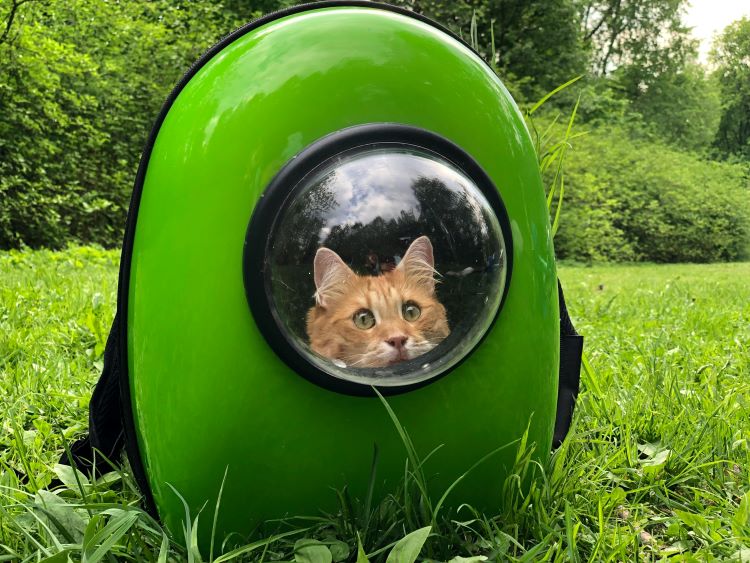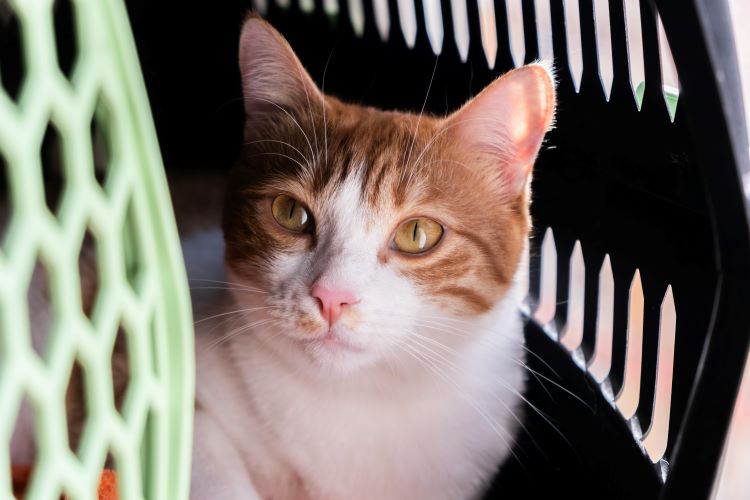Ready to help treat your pet to a healthy life?
How to Get a Cat into a Carrier
By : Alyssa Little & Trupanion Staff | Published May 29, 2025

Safe pet travel is an essential part of being a caring pet owner. Whether you are going on vacation with your feline friend, are boarding your cat (for those human-only vacations), or just need to take your kitten to the veterinarian, eventually you’ll likely need to get your cat in a carrier, which can be a stressful experience for all.
What one would imagine to be a (relatively) simple process can actually become quite complicated, depending on your cat’s behavior or mood. As we all know, cats are particular when it comes to their space. And not all cats take to carriers like bees to honey. So if you’re a new kitten owner — or even a seasoned cat owner — it’s important to recognize that getting a cat in a carrier is a somewhat specialized skill.
Ready to reduce the amount of yowling and drama every time you need to take your cat somewhere? Let this article serve as your guide.
Why do you need to know how to get a cat in a carrier?
Cats are independent creatures. Of course, they like their own space and rarely do things unless they really want to. So why interrupt that?
“It’s important that your cat is comfortable in a carrier, as this is the safest way to transport your cat from your house to another location," says Trupanion veterinarian, Dr. Sarah Nold. "This not only impacts your ability to get your cat safely to the veterinarian, boarding facility, or other location, but on the off chance you are faced with a natural disaster, it is also key to evacuating from your home."
Sure, most pet owners don't like to think they or their pet will ever be caught in one of these dangerous situations. But as responsible pet owners, it's important to always be prepared for emergencies.
If you do need to get your cat in a carrier quickly (like during an emergency), you may not want this to be your cat’s first experience with their carrier — it can scare your cat or confuse them. After all, not all cats like to be picked up or confined. Consider practicing over time so your cat becomes familiar with the carrier before it becomes a necessity.
A step-by-step guide for getting a cat into a carrier
Getting your pet into their cat carrier doesn’t have to be a Herculean task. While not all cats are going to wind up loving being in a pet bag or crate, there are some key steps you can take to help make getting your cat into a carrier easier for you and feline alike.
Every cat is unique and might take to the carrier differently. Some cats might go right in on the first try, while for others it is a learning curve. Nold advises all cat owners to adhere to the following steps for a successful cat carrier transition:
Step 1: Set up the carrier
Open the carrier and place it in a cat-accessible place where they will feel comfortable to come and go at their leisure. If possible, keep the carrier in a place that is already familiar to your cat. This will only increase your feline friend’s positive association with this newfangled contraption.
Step 2: Turn the carrier into a retreat
Add comfy bedding, favorite toys, or a familiar sweatshirt of yours — your scent will be a source of comfort to them. By making this an appealing place for your cat, they will be more inclined to explore and perhaps even settle in for naptime!
Step 3: Sweeten the deal with tasty treats
Once your cat has familiarized itself with the carrier, try providing an incentive for further exploration by leaving tasty treats or yummy meals inside the carrier. Make them special. Place the food that your cat adores in the carrier—with a daily routine, they might just begin to hang out in the carrier on a regular basis!
Step 4: Start with short trips
After establishing that the carrier is a safe cats-only place, it’s time for an adventure! This can be a problematic stage and you may need to place your cat in the carrier yourself.
But remember — don’t start with a week-long road trip. Short trips are the key to success when it comes to convincing your cat that the carrier is not a punishment but rather a vehicle to the world.
Step 5: Reconsider carriers
If all else fails, reconsider your carrier options. Your cat might just prefer a top opening versus a traditional door. Cats that tend to claw fabric may also do better in a bubble backpack. It may take some trial and error on your part to find just the right mode of transportation for your kitty, but be prepared to try each at least a few times before giving up.

Is my cat scared of the carrier?
Regardless of your cat’s age, size or breed, they may be scared of the carrier. Remember, new experiences, places, or people may scare some cats.
“I’ve heard more than once about a cat that runs and hides when the carrier is taken out of the closet or brought in from the garage,” says Nold. “If your cat is scared of the carrier, they often will fight you, (sometimes even scratch or bite) to prevent themselves from being put into the carrier. They may even begin to pant, drool, or vocalize if stressed.”
Consider your options and try your best to familiarize your cat with the carrier in stages. If that doesn’t do the trick, seek the guidance and expertise of your veterinarian as they can recommend a personalized course of action for your feline.
Patience and positivity: key for getting cats comfortable with a carrier
There is no set rule or system in place to get your cat to familiarize themselves with the carrier. It may take time for your cat to feel safe, comfortable, and at home. By taking the time to learn how to get your cat in a carrier, you can help lessen the stress and uneasiness for you and your furry family member.
"As with any training, try to keep it positive and go slowly,” Nold advises. "At the end of the day, you just want your cat to be safe, happy, and healthy."
Remember, your cat's health and well-being come first. By being patient with your cat and seeking the guidance of your veterinarian, you and your cat can safely travel together. Before you head out anywhere though, be sure to protect your cat with a good cat insurance plan. You never know what could happen!
